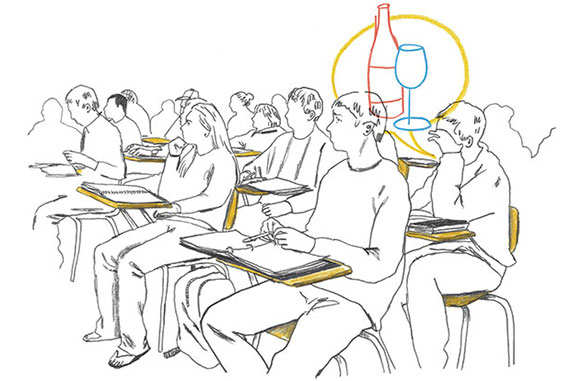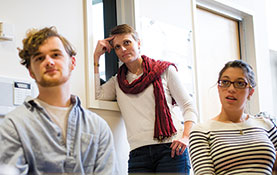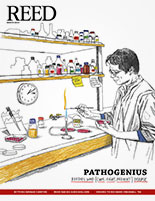
IRIS login | Reed College home Volume 92, No. 1: March 2013
Drinking and Thinking
Reed Psychology Professor Kris Anderson Leads Major Alcohol Study.
by Romel Hernandez
The Project Options video was produced by Reed College in October of 2013 with assistance from Lincoln and Franklin High Schools in Portland, where the pilot projects are being conducted.

Illustration by David Sparshott
“Duh, everyone drinks alcohol.”
“Whenever I’m at parties, everyone is totally smashed.”
“I guess because most of my friends drink, I want to drink, too.”
A half-dozen Reedies are in a campus lab pretending to be high schoolers. The mock session is part of training for a teen alcohol intervention program called Project Options, spearheaded by Professor Kris Anderson [psychology 2007–], who recently won a $545,000 grant from the National Institute on Alcohol Abuse and Alcoholism to study alcohol use among teenagers—and to determine the most effective strategies for prevention.
What distinguishes Project Options from other just-say-no-type–programs is its student-centered foundation. Rather than lecturing about the evils of alcohol and other drugs, the program involves youths in a down-to-earth, open-ended discussion about the underlying reasons they turn to intoxicants—difficult family situations, peer pressures, to celebrate, or to commiserate. The program foregoes the scared straight approach, aiming instead to develop practical skills and motivations kids need to make smart decisions about alcohol.
“When you just say no, you leave a vacuum,” Anderson says. Project Options helps them answer the question: “’So, what do I say yes to?’”
The first order of business in the very first class is debunking the myth that everybody drinks. National data suggest that roughly one of five high schoolers have gotten intoxicated in a given month—a much lower rate than most teenagers believe. This discrepancy is important because people who believe that most of their peers are drinking are themselves more likely to drink—a phenomenon known to social psychologists as pluralistic ignorance. Presenting teens with hard facts challenging their own opinions (normative feedback, in psych terms) gets the sessions off to a thought-provoking start.
Project Options stands out for its student-centered, not top-down approach, says Shay James, principal of Franklin High School, one of two Portland high schools where the study is taking place. She credits Anderson and her team for “doing the legwork” and “making connections with our students and parents.”

Professor Kris Anderson observes Hannah Stein ’13, Ben Morris ’15, and Mackenzie Callis ’13 playing the role of high school students in a mock intervention training session. Photo by Leah Nash
Anderson didn’t start out as an academic. After attending Bard College at Simon’s Rock and Drew University, where she got a taste for politics as a campus activist, she decided, she says, to “stop fighting the man and help real people.” At first she turned her attention to education. While earning a master’s degree she taught special education in an educational collaborative serving students with learning disabilities and behavioral disorders. She earned a doctorate in clinical psychology at the University of Kentucky and spent five years working with children, families, and adults.
As a postdoctoral fellow at the University of California at San Diego, she connected with her mentor, Sandra Brown, one of the nation’s top experts in adolescent substance abuse. There she honed her work as a researcher straddling the developmental and psychological aspects of substance abuse.
Anderson’s experiences at Simon’s Rock, a stalwart bastion of the liberal arts, drew her to apply for an open job at Reed. At first her research colleagues scoffed. “The people who didn’t know Reed thought I’d spend all my time teaching undergraduates and never get to the lab,” she says.
The reality of her experience has proved the doubters wrong. At Reed she has gotten passionate about teaching, even while running a robust research program that involves some of her students at Reed. “The research is integral to the teaching,” she says. “And the truth is, I have the nicest lab I’ve ever had—I’ve got windows!”
Anderson is also gathering data for her own research, studying the effectiveness of intervention strategies. She has involved current and former Reedies as research assistants, including Genevieve Dash ’13, who is doing an independent study as a project interventionist. “I’m getting to do a lot of the hands-on work in the schools,” says Dash, who is also collecting data for her senior thesis through the project. “It is so much more than I ever expected to do with my thesis, so it’s really exciting.”
Anderson also recently was awarded a Fulbright grant to work in the Netherlands for several months next year (she will be on sabbatical) to collaborate with faculty at the University of Amsterdam on research studying how youths decide to drink or not to drink. Her own work focuses on explicit cognition—the conscious decision-making process—and she will be working with a colleague researching implicit cognition—the subconscious process. “It’s the best of both worlds,” she says.
Project Options was initially created by Brown in 1999 as an alcohol-intervention program in San Diego–area schools. Now, under Anderson’s stewardship, the program is being rolled out at Franklin and Lincoln high schools in Portland. Before starting the sessions Anderson went into the schools to run focus groups, probing the school culture related to alcohol, and strategizing ways to market and shape the programs in ways that are meaningful to the students.
Project Options is confidential and voluntary, so a cross section of drinkers and nondrinkers attend the small sessions during their regular school day, lured, at least at first, by the offer of free pizza. The 20-minute meetings are staffed by trained interventionists. Over time, the students develop a support community for staying sober, gain skills to guide their choices about alcohol, and perhaps influence their own circle of friends.
Among the strategies: avoiding situations where alcohol is present, rehearsing in-the-moment excuses for passing up a drink (term paper due, big game coming up), finding alternative activities or supportive friends. While the program makes clear that abstention is the healthiest route to take, it’s also realistic about teen alcohol use. Ultimately, the goal is harm reduction, such as getting kids to drink less or not to drink and drive. Getting young people to think more about the decisions they make rather than just give in to outside pressures is the key.
“The major step is getting them to generate their own ideas,” says Anderson. “Many kids have found effective ways of abstaining in a way that fits within their social context, and what we do is provide a safe space for them to get information and learn from each other.”
GO FURTHER
See Adolescent Health Research Center
Anderson, K.G., & Briggs, K. (in press). “Self-regulation and adolescent decision making about alcohol and other drug use.” Oxford Handbook of Adolescent Substance Abuse.
Anderson, K.G., Grunwald, I., Grant, A., et al (2011). “To drink or not to drink: Motives and expectancies for use and nonuse in adolescence.” Addictive Behaviors.


LATEST COMMENTS
steve-jobs-1976 I knew Steve Jobs when he was on the second floor of Quincy. (Fall...
Utnapishtim - 2 weeks ago
Prof. Mason Drukman [political science 1964–70] This is gold, pure gold. God bless, Prof. Drukman.
puredog - 1 month ago
virginia-davis-1965 Such a good friend & compatriot in the day of Satyricon...
czarchasm - 4 months ago
John Peara Baba 1990 John died of a broken heart from losing his mom and then his...
kodachrome - 7 months ago
Carol Sawyer 1962 Who wrote this obit? I'm writing something about Carol Sawyer...
MsLaurie Pepper - 8 months ago
William W. Wissman MAT 1969 ...and THREE sisters. Sabra, the oldest, Mary, the middle, and...
riclf - 10 months ago